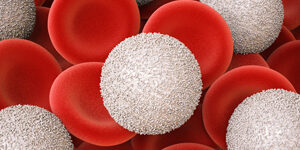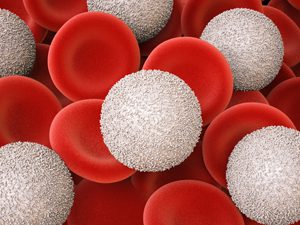Marianne T. Downes, PhD, MLS(ASCP)CM
The American Red Cross reports that in the United States, platelet transfusions are needed every 30 seconds.i This translates into a need of over 1 million platelet units annually. Platelets are clinically useful in a wide array of situations including correcting platelet loss due to massive hemorrhage, platelet deficiency secondary to chemotherapy, and supportive therapy for selected congenital platelet defects. Much of this need is met using single donor apheresis platelet concentrates (SDA-PC) which contain ≥3.0 x 1011 platelets suspended in a variable amount of donor plasma.
While there are studies that have shown increased platelet survival when ABO-compatible platelets are administered, there appears to be no difference in the clinical bleeding outcomes of patients administered ABO-compatible or ABO-incompatible plateletsii which leads to the therapeutic usefulness of major and minor ABO-incompatible platelets. The plasma contained in SDA-PC puts patients at risk of a hemolytic transfusion reaction (HTR) due to minor ABO incompatibility. While rare, HTRs due to the transfusion of Anti-A, Anti-B, and/or Anti-A,B antibodies into recipients with the reciprocal RBC antigens do occur and have been reported as contributing to adverse outcomes, including death, due to HTR in annual Serious Hazards of Transfusions (SHOT) reports and the FDA’s annual report. The risk of an HTR from transfusion of minor ABO-incompatible platelets is estimated at 1/9000.iii
The 29th edition of the Standards for Blood Banks and Transfusion Services published by AABB only recommends that facilities should have a policy in place to minimize the amount of incompatible plasma transfused into patientsiv, but there is no nationwide policy in place. Some facility policies take no consideration of ABO type and use platelets on a first-in/first-out basis due to the short shelf-life of the product and to keep wastage minimal. Other facilities transfuse ABO-identical platelets whenever feasible, and ABO-minor compatible whenever possible among a range of other policy variations. As reported by Joan Cid, Sarah K. Harm and Mark H. Yazer in their aptly named article “Platelet Transfusion-the Art and Science of Compromise,” each transfusion service must employ its own policies based on needs and keeping abreast of the current literature and still unanswered questions in transfusion science.v
While certain compromises must be made, given that transfusion of platelet concentrates worldwide contribute to nearly 25% of adverse events, a recent article in Blood Transfusion calls for improving the safety and efficacy of platelet transfusion.vi One suggested method of improving the safety of platelet transfusion includes using platelets with low-titer Anti-A and Anti-B antibodies when minor ABO-incompatible platelets must be used. Theoretically, this would lower the risk of HTR associated with platelet transfusion, but as yet there is an unsatisfying amount of data supporting the efficacy of such a policy.iii There are similar concerns and issues surrounding use of whole blood.
Part of the reason for lack of good data is there are a variety of methods by which titers can be performed (gel verses tube, testing serial dilutions of plasma verses positivity at a “trigger threshold”) and no consensus as to the titer threshold by which to consider low-titer and high-titer platelets. Various studies report cut-offs for designating high-titer anywhere from ≥1:64 to ≥1:250. Testing protocols vary widely. A local clinical affiliate for West Virginia University’s Medical Laboratory Science program aseptically separates a segment from only type O SDA-PC, dilutes the plasma 1:100 and tests against A1 cells for macroscopic agglutination by tube method. Those units whose diluted plasma yields agglutination are labeled “high-titer” and transfused only to type O recipients. There is no testing of Anti-B titers in platelets at this facility as HTR due to Anti-B is rarer than to Anti-A. A different facility reports the use of 1:20 dilution of plasma tested against A2B cells on microtiter platesiii to determine high-titer units. Thusly, it is difficult to compare data across centers. One method suggested to increase safety is for instrument manufacturers to develop and validate automated Anti-A and Anti-B titer screening.iii Another potential step would be if product suppliers were to implement validated titers on all platelet products, there would be consistent and comparable data to evaluate. A more robust reporting system that captures all adverse events, not just fatal events, would yield a more comprehensive body of outcomes from which to draw conclusions.
In conclusion, while we are not yet ready for implementation of new standards, we do appear to be moving in that direction. With the collection and reporting of more data, especially data that might indicate reduced risk of HTR when low-titer minor ABO-incompatible platelets are transfused verses no titer designation, we can feasibly make platelet transfusion safer and hopefully reduce the risk of HTR due to transfusion of minor ABO-incompatible platelets.
i American Red Cross. Platelet Donation. http://www.redcrossblood.org/platelets accessed 10/2/2016.
ii Triulzi DJ, Assmann, SF, Strauss RG et al. The impact of platelet transfusion characteristics on posttransfusion platelet increments and clinical bleeding in patients with hypoproliferative thrombocytopenia. Blood. 2012; 119: 5553-62.
iii Valsami,S, Dimitroulis,D, Gialeraki,A et al. Current trends in platelet transfusions practice: The role of OBO-RhD and human leukocyte antigen incompatibility. Asian J Transfus Sci. 2015; 9(2): 117-123.
iv Standards for Blood Banks and Transfusion Services 29th ed. AABB, Bethesda, MD. 2014.
v Cid J, Harm CK, Yazer MH. Patelet transfusion- the art and science of compromise. Transfus Med Hemother 2013; 40 160-171.
vi Garraud O, Congnasse F, Tissot, JD, et al. Improving platelet transfusion safety: biomedical and technical considerations. Blood Transfus. 2016; 14; 109-22.

